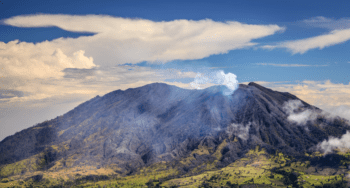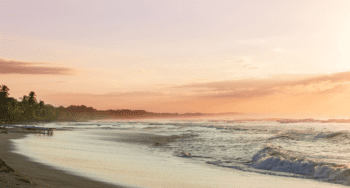Puerto Viejo Costa Rica: What's Covered
Puerto Viejo de Talamanca offers Afro-Caribbean culture and reggae rhythms completely different from Costa Rica’s Pacific coast, located 4-5 hours from San José via Route 32. This Caribbean gem stays surprisingly sunny August-October when Pacific destinations get drenched. Having a rental car from Vamos makes exploring easier, though bikes handle the 13-kilometer beach road perfectly from town to Manzanillo.
Quick Facts:
- No 4×4 needed—newly paved Route 32 requires just decent ground clearance
- Budget $50-70 daily for hostels and sodas, $100-150 for comfortable stays
- Best weather: February-April (driest) or August-October (sunny while Pacific rains)
- Punta Uva ranks as most beautiful beach, 8km south with crystal-clear water
- Cahuita National Park operates on donations 20 minutes north
Top 4 Must-Do Activities:
- Beach Hop by Bike – Explore Cocles, Chiquita, Punta Uva, and Manzanillo beaches within 45 minutes cycling
- Jaguar Rescue Center – $20-25 tours showing rehabilitation of sloths, monkeys, and margay cats
- Chocolate Tours – $30-35 experiences at working cacao plantations with tastings and wildlife
- Surf Salsa Brava – January-April brings world-class waves for experienced surfers only
Puerto Viejo rewards travelers embracing its different pace—plan 3-5 days minimum to properly experience Caribbean Costa Rica’s unique culture.
If you need any help with a Costa Rica car rental, contact us now!
Puerto Viejo de Talamanca isn’t your typical Costa Rican beach town. While most visitors flock to the Pacific coast for predictable sunshine and resort towns, this Caribbean gem offers something completely different—Afro-Caribbean culture, reggae rhythms, coconut-infused cuisine, and a laid-back vibe that makes the rest of Costa Rica feel rushed. Located on the South Caribbean coast about 4.5 hours from San José, Puerto Viejo attracts travelers looking for world-class surfing at Salsa Brava, stunning beaches like Punta Uva, wildlife encounters at the Jaguar Rescue Center, and a cultural scene shaped by indigenous Bribri traditions and Jamaican influences. The best part? When the Pacific coast drowns in rain from August through October, Puerto Viejo stays surprisingly dry.
Key Takeaways
- Puerto Viejo offers a completely different Costa Rica experience with Afro-Caribbean and indigenous Bribri influences rather than typical Latin American culture.
- The Caribbean coast enjoys sunny weather between August – October, when the Pacific coast gets hammered with rain.
- You don’t need a 4×4—the newly paved Route 32 makes the drive straightforward from San José.
- Beach hopping is the main activity, with each beach offering distinct vibes within 15 minutes by bike.
- Surfing peaks January-April when Salsa Brava comes alive, but diverse activities keep the town busy year-round.
- Budget-conscious travelers find excellent value compared to Pacific coast hotspots.
How Does Puerto Viejo Compare to Other Destinations?
Tamarindo on the Pacific coast offers consistent sunshine and developed infrastructure. Puerto Viejo counters with authentic culture, less development, more affordable prices, and beaches that stay crowd-free even during high season.
Manuel Antonio combines beaches with accessible wildlife viewing just 3 hours from San José. Puerto Viejo requires more commitment (4.5 hours) but rewards you with more beach variety, deeper cultural immersion, and lower prices. Manuel Antonio’s national park draws huge crowds; nearby Cahuita National Park operates on donations and sees far fewer visitors.
Compared to quieter Caribbean neighbors like Cahuita (more relaxed, smaller) and Manzanillo (fishing village, very quiet), Puerto Viejo offers the most services and nightlife while maintaining that Caribbean vibe.
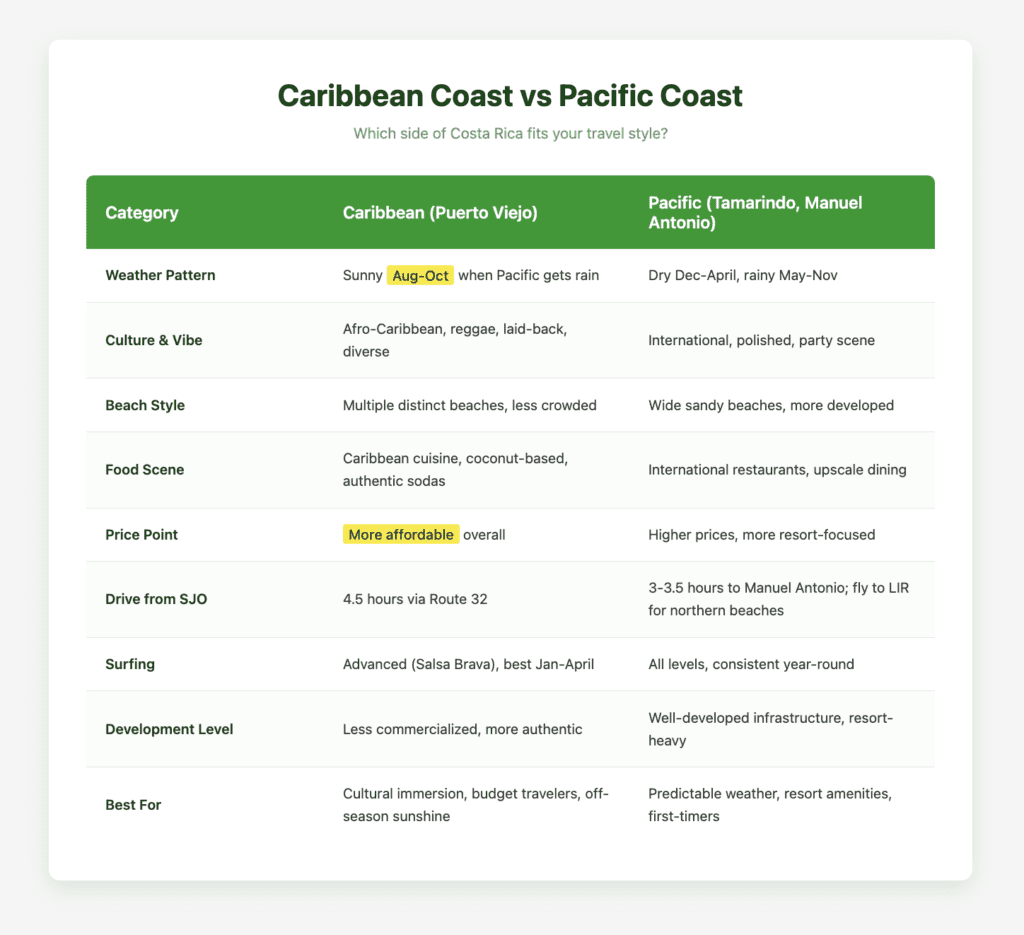
What's the Real Budget for Puerto Viejo?
Accommodation: Hostel dorms run $12-25 USD, private guesthouse rooms $40-70 USD, vacation rentals $60-120 USD, boutique hotels $100-180 USD, luxury eco-lodges $180-300+ USD.
Food: Casados at local sodas cost $5-8 USD, restaurant meals $12-20 USD per person, beachside cocktails $6-10 USD, gelato $3-5 USD.
Activities: E-scooter rental $40 USD daily, bicycle rental $8-12 USD, Jaguar Rescue Center $20-25 USD, chocolate tours $30-35 USD, Cahuita National Park donation-based (suggested $5 USD).
Daily Budget Examples: Budget travelers spend $50-70 USD (hostel, sodas, bike rental), mid-range travelers $100-150 USD (vacation rental, mixed dining, activities), and comfortable travelers $200-300 USD (boutique hotel, tours, e-scooter).
How Do You Actually Get to Puerto Viejo?
Which Route Works Best from San José?
Route 32 through Braulio Carrillo National Park takes 4-5 hours. The roads are now well-paved with widened lanes. Traffic backs up with trailer trucks on single-lane sections, so start early (before 7 AM) to avoid congestion. Don’t drive at night—elevation changes, fog, and wildlife make it risky.
As you approach Puerto Viejo, expect minor bumps—just slow down. A regular car with decent ground clearance handles everything fine. You don’t need a 4×4 for Puerto Viejo, though having a reliable rental from Vamos makes exploring beaches easier than relying on buses.
What About Flying or Taking the Bus?
Limón Airport is 1.5 hours away. SANSA Airlines flies from San José (40 minutes, $85 USD one-way), but you’ll still need ground transportation to Puerto Viejo.
Public buses (MEPE line) run four times daily from San José’s Terminal Atlantico Norte at 6 AM, 10 AM, 3:45 PM, and 4 PM. The journey takes 5 hours and costs about $12 USD one-way. Arrive an hour early to secure seats.
Shuttle services like Interbus charge $57 USD per person shared or $220 USD private. They’re more comfortable than buses but less flexible than having your own vehicle.
How Do You Get Around Once You're There?
Puerto Viejo stretches along a single main road with beaches lined up like beads. This makes bikes and electric scooters perfect transportation. E-scooters rent for $40 USD daily and handle the 13-kilometer stretch to Manzanillo easily. Maximum biking time to any point is 45 minutes, though most spots fall within 20 minutes.
If you drove from San José, keep the car for day trips to Cahuita (20 minutes) or the Bribri waterfall (25 minutes). Park it at your accommodation and bike for daily beach hopping.
When Should You Visit Puerto Viejo?
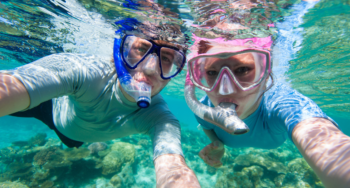
What Makes the Caribbean Coast Different?
Here’s the secret: when the Pacific coast gets drenched during “green season” (August-October), Puerto Viejo often stays sunny. Different weather systems affect each coast, giving the Caribbean better weather during these months while Pacific towns see daily downpours.
February-April represents the driest period. Hotels fill up, especially around Easter. Book well in advance.
August-October offers sunny days while the rest of Costa Rica floods. Fewer tourists mean better prices and less crowded beaches.
January and November bring mixed weather with both sunshine and rain.
When Does Surfing Peak?
January through April brings the biggest, most consistent swells. Salsa Brava—Puerto Viejo’s legendary reef break—truly comes alive, attracting experienced surfers worldwide. The wave breaks over a shallow reef and demands respect; it’s not a beginner spot.
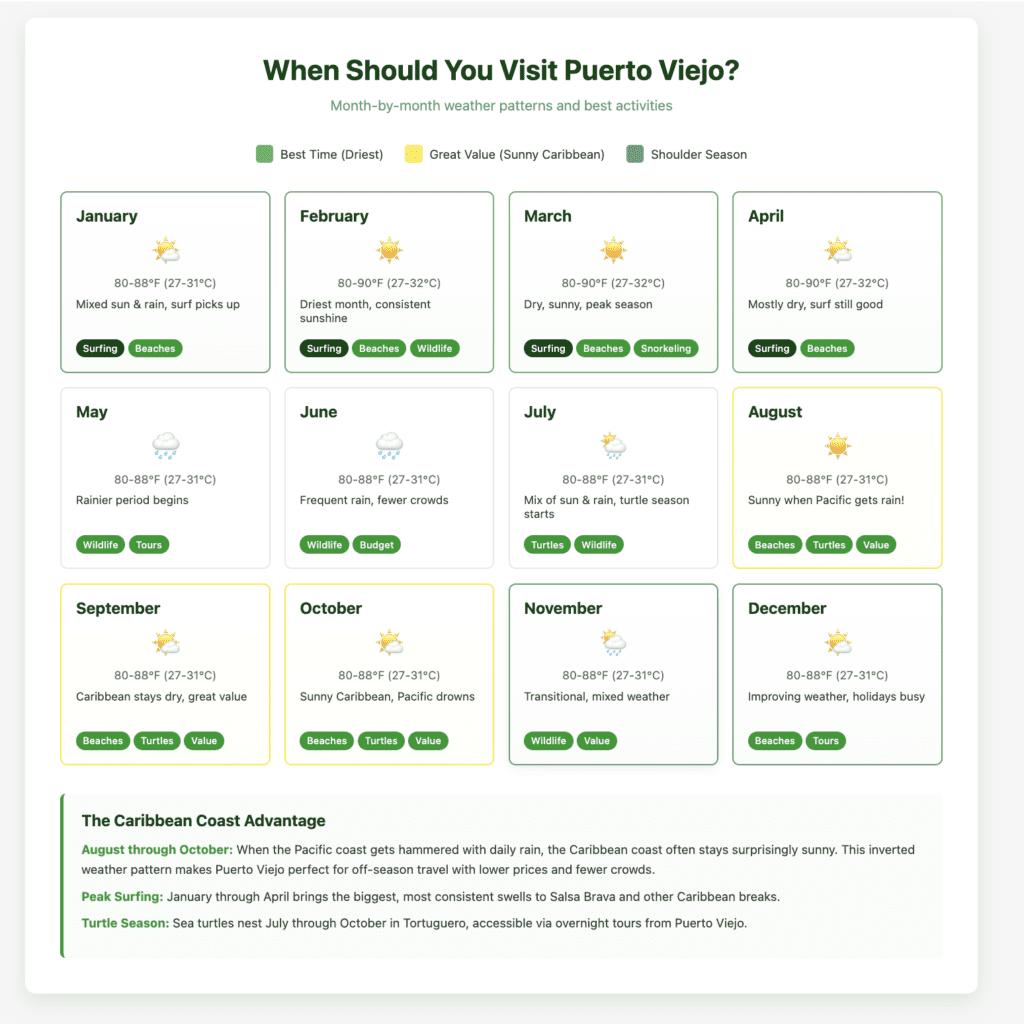
Where Should You Stay in Puerto Viejo?
What’s the Difference Between Town and Beach Road?
Puerto Viejo town centers around restaurants, shops, and bars with that Caribbean village feel. You’ll walk to nightlife easily, though the town beach isn’t the area’s most impressive.
The “beach road” stretches south through Playa Cocles, Playa Chiquita, and Punta Uva to Manzanillo (13 kilometers away). Hotels here offer beachfront access and tranquility, but require bikes or vehicles to reach town.
Most travelers prefer accommodations along the beach road for superior beaches while making occasional trips into town.
Which Hotels Actually Deliver?
Hotel Banana Azul (Playa Negra, 4.5+ rating) offers beachfront rooms with a beach club, restaurant, and spa services.
Cariblue (Playa Cocles, 4.5+ rating) features two pools, a swim-up bar, jacuzzis, a spa, a restaurant, and surf school—more resort-style while maintaining local character.
Tree House Lodge (Near Punta Uva, 4.8+ rating) provides five luxury eco-houses across 10 acres near the area’s most beautiful beach.
Vacation rentals range from simple apartments near town ($60-80 USD nightly) to beachfront houses ($150-300 USD).
Hostels like Playa 506, Selina, and Lionfish offer dorms ($12-25 USD) or private rooms ($40-60 USD).
Which Beaches Should You Actually Visit?
Why Is Punta Uva Special?
Punta Uva (8 kilometers south) consistently ranks as the area’s most beautiful beach. White sand meets crystal-clear water framed by palm trees, creating that postcard scene. Natural rock formations break waves in sections, creating calm pools perfect for families. Costa Rican law prohibits private beach ownership, so every beach stays accessible to everyone.
What About the Other Beaches?
Playa Cocles (3 kilometers from town) offers consistent surf and expansive golden-brown sand. Strong waves demand respect from swimmers. Several hotels and restaurants provide nearby amenities.
Playa Puerto Viejo (Chino Beach) works for quick dips when you don’t want to bike. Natural rock pools create gentler swimming. Beach shacks like Pirata Tike Bar serve food and drinks steps from the sand—perfect for sunset cocktails.
Playa Chiquita sits between Cocles and Punta Uva with a more tranquil, less developed feel. Good swimming (watch the waves) and easy access to scattered accommodations.
Manzanillo marks the end of the road (13 kilometers from town). This tiny fishing village within the Gandoca-Manzanillo National Wildlife Refuge offers long, wild beaches with fewer people. Playa Grande stretches endlessly with a famous shipwreck and pelican flocks. Excellent restaurants make it worth the bike ride.
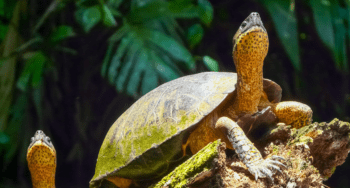
What Activities Matter Beyond Beaches?
Why Visit the Jaguar Rescue Center?
This sanctuary offers refuge to injured, orphaned, or electrocuted wildlife. Sloths, monkeys, birds, and a margay cat receive rehabilitation care. Two morning tour slots ($20-25 USD, 90 minutes) provide insights into each animal’s story. Important rules: no touching, no photography during certain periods, no interactions disrupting rehabilitation. The center operates entirely through entrance fees and donations. After tours, walk the grounds during afternoons when many residents roam freely.
Is Cahuita National Park Worth It?
Cahuita sits 20 minutes north by car, 45 minutes by bike. The park protects 8 kilometers of coastline with rainforest, beaches, and coral reefs. Easy trails follow the coast, offering ocean views while sloths, raccoons, and monkeys appear in trees. Entry operates on donation (suggested $5 USD). Bring water and swimming gear—you can swim at various beaches along the route.
What’s the Chocolate Tour Experience?
Cacao Trails and Caribbean Chocolate Tour guides visitors through working plantations where cacao grows under the rainforest canopy. Tours ($30-35 USD, 2-3 hours) include seeing cacao pods, tasting the sweet fruit, learning fermentation and drying, and grinding your own chocolate. Create custom chocolate by adding tropical fruits or spices. Cacao Trails specifically winds through the forest where wild capuchin monkeys and sloths sometimes appear.
Where’s the Bribri Waterfall?
The Bribri indigenous community lives near the Panama border, maintaining a distinct language and traditions. The waterfall requires a 25-minute drive followed by a guided walk from the village. Tours include the village visit, waterfall hike, and often a traditional lunch. You don’t need a 4×4 even during the dry season.
What About Tortuguero National Park?
Tortuguero on the northern Caribbean coast operates like Costa Rica’s Amazon—canals replace roads. The park requires overnight trips (starting $140 USD per person), including transportation, accommodation, meals, and boat tours. Wildlife density is incredible: caimans, river turtles, sloths, poison dart frogs, and countless birds. During turtle nesting season (July-October), nighttime beach walks offer chances to witness sea turtles laying eggs. Plan a trip to this amazing area before or after your stay in Puerto Viejo.
Does Surfing Require Experience?
Salsa Brava breaks over a shallow reef, generating powerful waves demanding respect—exclusively for experienced surfers. Playa Cocles offers more forgiving waves for intermediate surfers. Several surf schools teach beginners at Cocles rather than Salsa Brava. Best surf season runs January-April when Caribbean swells peak.
What About Other Activities?
White water rafting on the surrounding rivers costs $75-100 USD and combines adrenaline with rainforest wildlife viewing. Bird watching reveals over 300 species, including Great Green Macaws found only on Costa Rica’s Caribbean side. Early morning walks (before 7 AM) provide the best viewing. Ara Manzanillo focuses on restoring endangered populations and is open to visitors.
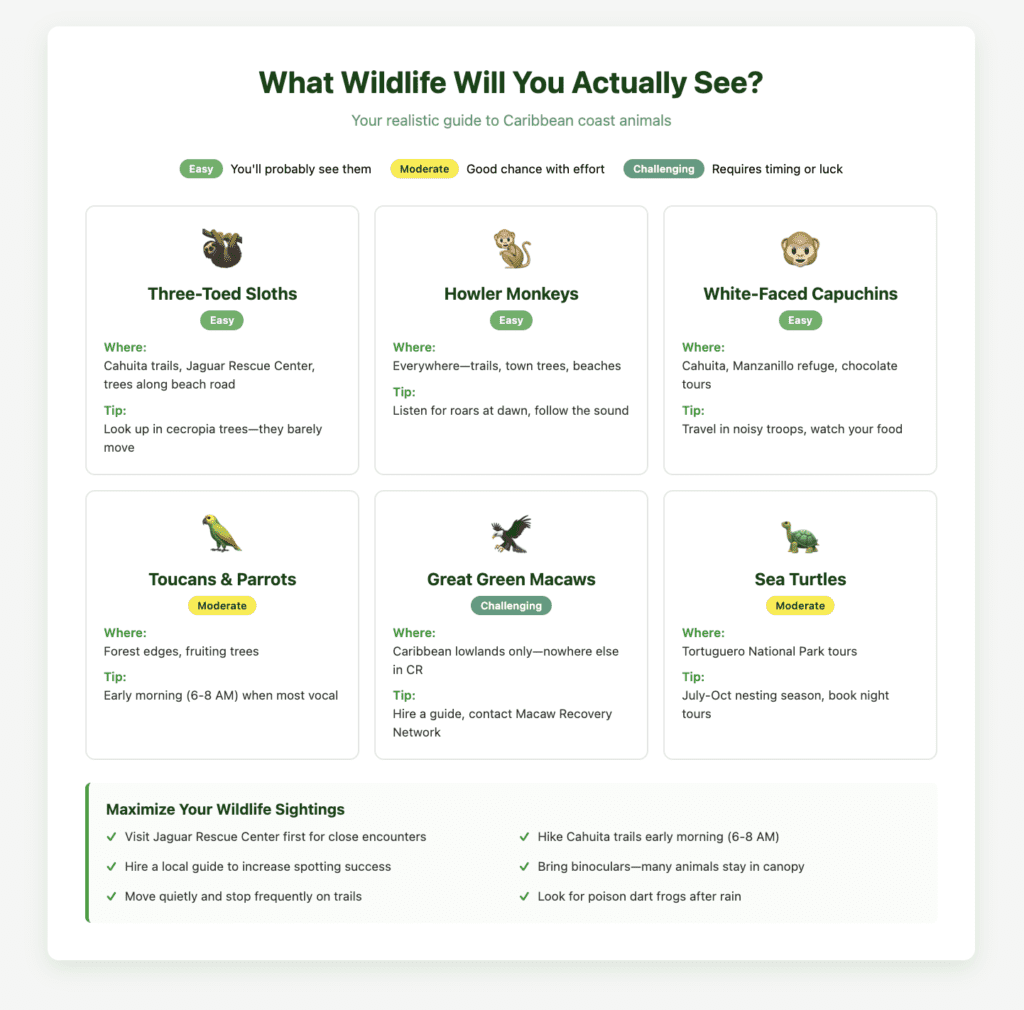
Where Should You Eat in Puerto Viejo?
Caribbean-influenced food dominates—coconut milk flavors rice and beans, jerk seasoning spices proteins, patí (Caribbean empanadas) fills lunch menus, and fresh seafood appears everywhere.
Soda Lidia’s (4.5+ rating) exemplifies authentic local Caribbean cuisine with homemade hot sauce and traditional rice and beans ($5-8 USD).
Bread and Chocolate (4.8+ rating) serves breakfast and lunch with fresh-baked goods and creative plates.
Koki Beach Lounge (4.6+ rating) excels at seafood and steaks ($12-20 USD per entrée).
La Pecora Nera (4.7+ rating) delivers authentic Italian pizza and pasta ($20-35 USD per person).
Stashu’s con Fusion (4.6+ rating) offers creative drinks and excellent desserts with refined dining.
Deelite (4.8+ rating) serves gelato rivaling Italy with tropical flavors.
Local sodas throughout town serve authentic casados for $5-8 USD—best value and often most authentic Caribbean flavors.
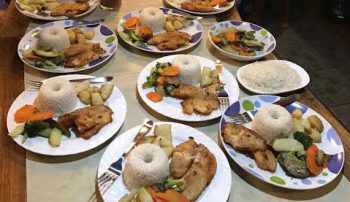
What Should You Know About Practical Stuff?
Safety: Puerto Viejo experiences typical beach area petty theft. Don’t leave valuables on beaches, lock accommodations, and avoid walking alone or drunk late at night. Violent crime against tourists remains rare. Use common sense.
Money: Several ATMs operate in town, but sometimes run out during busy weekends. Many places accept US dollars, but you’ll get better value with colones. Keep enough cash for a few days—smaller places operate cash-only.
Cell Service: Coverage works reasonably well in town and along the beach road. WiFi at accommodations handles messaging and email, but often struggles with streaming.
Water: Tap water is generally safe, though some travelers prefer bottled water during the first few days. Many accommodations provide filtered water stations.
Groceries: Small stores stock basics. Don’t expect a massive selection. For serious shopping, some make runs to Hone Creek’s budget Pali supermarket.
How Should You Plan Your Itinerary?
3 Days Minimum: Several beaches, one tour (Jaguar Rescue or chocolate), absorb the vibe.
5 Days Ideal: Beach hopping, two to three activities, genuine relaxation time.
Sample 3-Day Plan:
- Day 1: Arrive afternoon, settle in, explore town, dinner at Soda Lidia’s
- Day 2: Morning Playa Cocles, afternoon Punta Uva, evening town dinner
- Day 3: Cahuita National Park morning hike, afternoon Chino Beach, farewell dinner
Sample 5-Day Plan:
- Day 1: Arrive, afternoon Playa Cocles
- Day 2: Morning Jaguar Rescue Center, afternoon Punta Uva
- Day 3: Morning chocolate tour, afternoon Playa Chiquita
- Day 4: Full day in Cahuita National Park
- Day 5: Morning Manzanillo bike ride, afternoon final beach time, farewell dinner at La Pecora Nera
Week-Long Plans: Add Tortuguero overnight, white water rafting, Bribri waterfall, surfing lessons, or simply slow down.

What's Your Next Step?
Puerto Viejo rewards travelers who embrace its different pace and cultural flavor. Book accommodations along the beach road between Cocles and Punta Uva for the best beach access while keeping the town’s restaurants within biking distance. Plan to stay at least three full days, but ideally longer.
The drive from San José takes 4-5 hours on well-maintained roads that don’t require a 4×4. Renting from a company like Vamos that specializes in Costa Rica means getting a vehicle that handles everything from the airport to Puerto Viejo without issues, plus local knowledge from staff who actually know these routes.
Visit August-October for sunny Caribbean weather while the rest of Costa Rica gets rain, or February-April for the driest conditions. Leave room for spontaneity—discovering a new beach, stumbling into an amazing meal, or extending your stay because the vibe works. That’s the Caribbean coast effect, and it’s exactly what makes this corner of Costa Rica worth the drive.
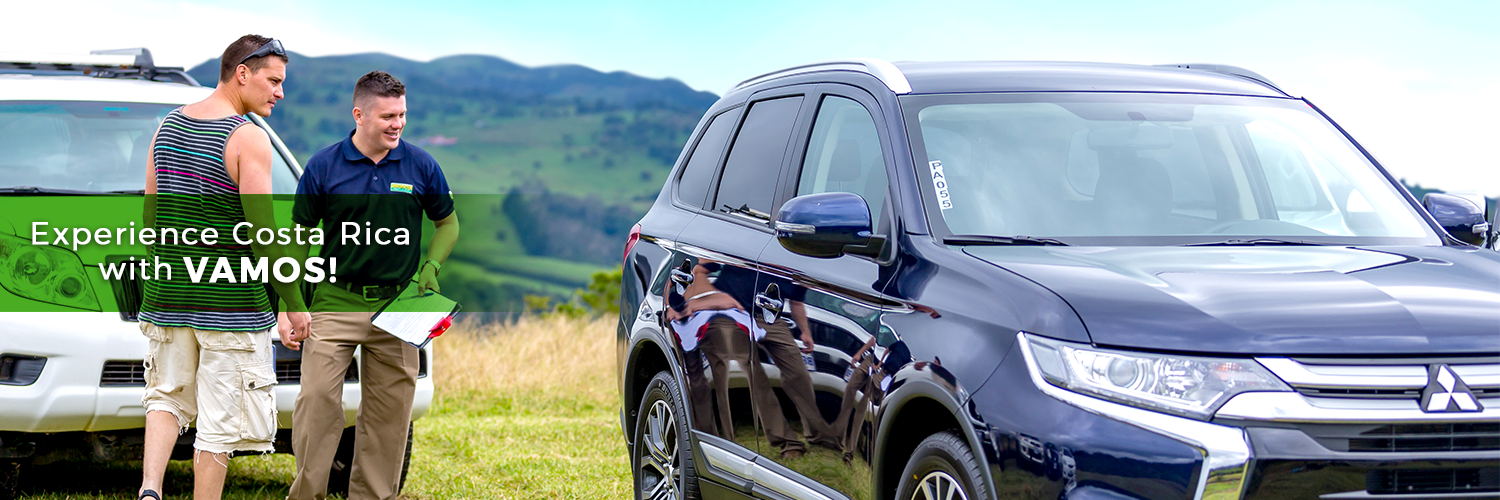
Frequently Asked Questions
Do I need a 4×4 to drive to Puerto Viejo from San José?
No, you don’t need a 4×4. The Route 32 drive from San José to Puerto Viejo is now well-paved with widened lanes—a huge improvement from years past. A regular sedan or SUV with decent ground clearance handles the route just fine.
You’ll encounter some rough patches on the roads near Puerto Viejo. Just slow down and you’re good. The roads are totally manageable without 4-wheel drive.
Pro Tip: A car with slightly higher clearance (like a small SUV) gives you more comfort on those bumpy sections, but it’s not required. Regular cars make this drive every single day without issues.
How many days should I spend in Puerto Viejo?
3 days minimum, 5 days ideal. Here’s why: Puerto Viejo has six distinct beaches within 30 minutes of each other, plus activities beyond just beaches (Jaguar Rescue Center, Cahuita National Park, chocolate tours, snorkeling).
Three days lets you hit the highlights—a couple of beaches, one or two activities, and get a feel for the Caribbean vibe. Five days gives you time to properly beach hop, take a few tours, maybe do a Tortuguero overnight trip, and actually relax instead of rushing.
If you’re a surfer chasing Salsa Brava waves or someone who just wants to decompress completely, a week works perfectly. The laid-back pace makes longer stays feel natural rather than excessive.
Is Puerto Viejo safe for tourists?
Yes, with normal precautions. Puerto Viejo is generally safe, but like any beach tourism areas there is petty theft. Unattended bags disappear from beaches, unlocked rental cars get rifled through, and valuables left visible attract opportunistic thieves.
Violent crime against tourists is rare. The main issues are theft of opportunity, not assault or serious crime. Here’s what works:
- Don’t leave stuff on the beach when you swim
- Lock your accommodations and car
- Avoid walking alone, drunk, late at night in unlit areas
- Don’t flash expensive jewelry or electronics unnecessarily
The laid-back vibe can make you complacent—that’s exactly when theft happens. Stay aware without being paranoid, and you’ll likely have zero issues.
When is the best time to visit Puerto Viejo?
February through April for guaranteed sunshine, August through October for the secret advantage.
Feb-April represents the driest, most consistently sunny period. Hotels fill up and prices peak, but you’re almost guaranteed great weather. If you’re visiting during these months, book accommodations well in advance, especially around Easter.
Here’s the insider knowledge: August through October offers sunny Caribbean days while the Pacific coast drowns in rain. Different weather systems affect each coast, so when Tamarindo and Manuel Antonio see daily downpours, Puerto Viejo often stays surprisingly dry and sunny. You’ll get occasional rain, but nothing like the Pacific side. Plus, fewer tourists mean better prices and less crowded beaches.
Surfing Note: January through April brings the biggest, most consistent swells to Salsa Brava. If you’re chasing waves, visit during these months.
What’s the best beach in Puerto Viejo?
Punta Uva consistently wins for overall beauty, but the “best” beach depends on what you want:
Punta Uva (8 km south): White sand, crystal-clear water, palm trees leaning over the beach, and natural rock pools creating calm swimming areas. This is the postcard-perfect Caribbean scene everyone imagines.
Playa Cocles (3 km south): Best for surfing with consistent waves and multiple peaks. More energetic vibe with surf schools and beachside restaurants.
Chino Beach (in town): Most convenient for quick dips and sunset cocktails when you don’t want to bike anywhere. Not the prettiest, but the accessibility and beach bars make it great for casual afternoons.
Manzanillo (13 km south): Wild, less developed, long stretches of sand with fewer people. Worth the bike ride for solitude.
The beauty of Puerto Viejo is having all these different beaches within 30 minutes by bike. Spend a day beach hopping and decide which vibe fits you best.
Is Puerto Viejo expensive compared to other Costa Rica destinations?
No, Puerto Viejo is actually more affordable than Pacific coast hotspots. You’ll pay less here than in Tamarindo, Manuel Antonio, or the fancy Guanacaste beach towns.
Budget breakdown: Hostel dorms run $12-25/night, casados at local sodas cost $5-8, bike rentals are $8-12/day, and Cahuita National Park operates on donation (suggested $5). A budget traveler can do Puerto Viejo for $50-70/day comfortably.
Mid-range travelers spending $100-150/day get vacation rentals, mix of local and nicer restaurants, e-scooter rentals, and activities. Even upscale boutique hotels ($150-250/night) cost less than comparable Pacific coast properties.
The lack of big resorts and heavy commercialization keeps prices reasonable. Authentic sodas run by local families serve amazing Caribbean food for a fraction of what you’d pay at tourist restaurants in Tamarindo.
Should I stay in Puerto Viejo town or along the beach road?
Stay along the beach road between Cocles and Punta Uva for the best beaches, then bike into town when you want restaurant variety or nightlife.
Puerto Viejo town puts you within walking distance from restaurants, bars, and services, but the town beach (Chino Beach) isn’t the area’s most impressive. You’ll end up biking to better beaches anyway.
The beach road south of town gives you direct access to Playa Cocles, Playa Chiquita, and Punta Uva—the area’s best swimming and scenery. Hotels here offer more tranquil settings, though you’ll need bikes or a car to reach town (10-20 minutes).
Most travelers prefer the beach road location. You get the superior beaches for daily use while keeping the town’s dining and nightlife within easy reach by bike. Best of both worlds.


